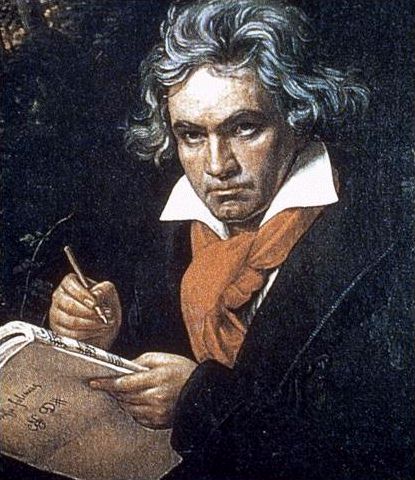![]()
AGE 50 - 51 [1821]
Compiled by Gary D. Evans
|
Last Updated:
March 20, 2019 4:59 PM
|

|
THE LAST DECADE VIENNA - 1821 (Age 50)
|
WORKS CREATED
| op 109, 110, 111 | (Beethoven set aside the Missa over 1820-22 in writing the set of Piano Sonatas: op 109, 110, 111 for pub. Adolf Schlesinger 1820 - 1822.) |
| op 110: Piano Sonata #31 in Ab |
(w/early finale)(fair copy dated Dec, 25) (was init. to be ded. to Antonie Brentano but was not, despite being, "under great obligation to her" [Anderson #1237] (Humor in middle movement: Allegro Molto alludes to 2 popular songs "Unsa katz had Zatzln ghabt" or "Our cat has had kittens" ("our cat has had kittens - Three and Six, Nine - one of them has a mark on its head - that'll be mine."[see L. Decade pg 190]) & "Ich bin luderlich, da bist luderlich" or "I'm dissolute, you're dissolute". Wrapped ~allegro molto are reflective, transcendental mvmts. B's inscription over entire transition in the closing fugue "nach und nach wieder auflebend" or "gradually returning to life" Conclusion lies beyond the last chord bA in a rapport with silence. The 3rd movement is one of the most original of Beethoven's [L.Decade pg191] This was being concurrently written along with op.111. Sketches appeared along with the Agnus Dei of the Missa. |
| op 111: Piano Sonata #32 in c (sketches) | (1st sketches ~ December) completed Jan.13, 1822. (Intended for Antonie Brentano but in the end B. offered no dedication. The publisher took it upon themselves to dedicate it to Archduke Rudolph! [Wegeler/Ries p185]) |
| op 119 #1-6: 11 Bagatelles | (Compl. late Nov. 1st 5 completed by early 1821 for an instruction book) |
| op 119 #7-11: Bagatelles | (Presented to Starke Jan1st for his piano method) (Probably referred to in letter to Brentano "...Since I have been compelled to write a considerable number of potboilers, as I must unfortunately call them [L. Dec p43]) |
| WoO 61: Allegretto in b | |
| WoO 182: 3 part canon "O Tobias!" | (Sep) (Sept 10. Sent to Haslinger. Occurred to him in a dream night before - modified after he awakened) |
| WoO 205f: "Scheut euch night" | (letter to Treitschke #1068 set to music) |
| Hess 65: Little Concert Finale in C, (Arr of coda & finale of 3'd Piano Concerto, op. 37) | (Arrangement of coda and finale of 3'd Piano Concerto, op. 37) |
BIOGRAPHICAL NOTES
|
DATE
|
|
|
Jan
|
After brief recovery from his previous illness, B. ill again with rheumatic fever x 6 weeks and completely bedridden (delaying work on op110-op111). |
|
Mar 31
|
Josephine Deym-Brunsvik-Stackelberg died after being ill for a long while. [Note: conv. books exist from 1820 & 1822 but 1821 book not found, also there are no letters from Mar14-June7] |
|
June
|
Moved to Unterdobling: 11 An der Winterzeil (now Silbergasse 9) through the end of September. |
|
July-erly
|
B. still not feeling well; Jaundice developed & persisted for over 4 weeks. |
|
Sept
|
His physician ( ) sent B. to Baden to take a cure. |
|
Autumn
|
B. arrested as a vagrant & taken to police station just outside Vienna where identified by Herzog, musical director in Wiener Neustadt on the following morning; immediately thereafter released w/ apology. |
|
Oct
|
Moved to Baden: Grosses Haus der Augustiner, Rathausgasse 94 (now #10) until May 1822? |
|
Nov
|
?? Back in Vienna ?? "it soon became cold at Baden and I was overtaken by an attack of diarrhea so violent that I could not continue the course of treatment and had to flee here"[L.Dec p43] |
|
Nov 12
|
Wrote to Franz Brentano that he had recovered from his illness that had been very severe and implied that the Missa was completed. Wrote: "I may again start a new life to be devoted to my art. This I have had to renounce for almost two years, both for lack of health and also on account of many other human sorrows" [Anderson #1059] |
|
Dec 6
|
B. sent dedicatory copy of Sonata op109 to Maximiliana Brentano, Antonie's daughter (his illness had delayed its earlier completion) |
![]()